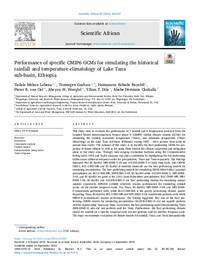Performance of specific CMIP6 GCMs for simulating the historical rainfall and temperature climatology of Lake Tana sub-basin, Ethiopia

Authors:
This study aims to evaluate the performance of 7 rainfall and 6 temperature products from the Coupled Model Intercomparison Project phase 6 (CMIP6) Global climate models (GCMs) for simulating the rainfall, maximum temperature (Tmax), and minimum temperature (Tmin) climatology of the Lake Tana sub-basin (Ethiopia) during 1995 – 2014 periods from daily to annual time scales. The rational of this study is to identify the best performing GCMs for projection of future climate as well as for using those models for climate adaptation and mitigation plans in the study area. Through wide-ranging evaluation methods using the Comprehensive Rating Index (CRI) and Taylor diagram, our study contributes by highlighting the top performing GCMs across different temporal scales for precipitation, Tmax and Tmin separately. The findings indicated that EC-Earth3, MPI-ESM1-2-LR and ACCESS-ESM1-5 at daily time scale, and CNRM-CM6-1, BCC-CSM2-MR and EC-Earth3 at monthly timescale are the best performing models for simulating precipitation. The best performing models for simulating MAM (March-May) seasonal precipitation are BCC-CSM2-MR, MPI-ESM1-2-LR, EC-Earth3 while ACCESS-ESM1-5, MPI-ESM1-2-LR, and EC-Earth3 are good at for JJAS (June-September) precipitation. BCC-CSM2-MR, MPI-ESM1-2-LR, EC-Earth3 and ACCESS-ESM1-5 are best performing models for simulating annual rainfall. Conversely, MIROC6 exhibits relatively weaker performance for simulating rainfall across all the studied temporal scales. For Tmax, EC-Earth3, MPI-ESM1-2-LR, and MRI-ESM2-0 consistently performed well, while BCC-CSM2-MR is the poorly performing climate model. Regarding Tmin, EC-Earth3, BCC-CSM2-MR and MPI-ESM1-2-LR consistently perform well, while MIROC6 demonstrates weaker performance. The finding suggested that one of the best performing CMIP6 models for simulating precipitation (ACCESS-ESM1-5) did not equally perform well for representing Tmax and Tmin. In addition, the best performing model for simulating Tmax (MRI-ESM2-0) also did not perform well for Tmin. Furthermore, the best performing climate model for rainfall on a specific temporal scale did not perform well on another temporal scale. The study recommends evaluation of climate models for rainfall, Tmax, and Tmin independently at different time scales for better understanding of future climates using the best performing models for each climate variable as well as for effective climate adaptation and mitigation plans.
